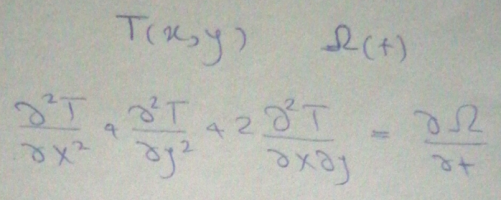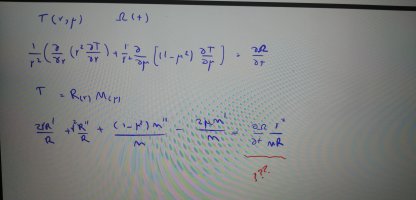You are using an out of date browser. It may not display this or other websites correctly.
You should upgrade or use an alternative browser.
You should upgrade or use an alternative browser.
A partial differential equation
- Thread starter Navid555
- Start date
D
Deleted member 4993
Guest
The leftHandSide of the PDE is function of x &y and the rightHandSide is a function of 't'. So, if x and y are not function of 't' (in general those are orthogonal to each other) then we can write both LHS and RHS to be equal to a constant 'K'.Hello. I have two quastion about this diffrential equation :
1.is this hemogenios?
2.how can I solve? (can I solve It with seperation method?)
View attachment 32776
Since that "constant" can be any number, NOT necessarily equal to zero, the whole PDE is NOT 'homogeneous'.
Yes - you start to solve it through separation of variable like:
T(x,y) = G(x) * H(y)
Thank you for your help. I use seperation method to solve the equation that is in the picture. But nonhemogenios term prevents seperation. Should I solve hemogenios form of this equation first? How can I solve nonhemogenios part of this problem?
The leftHandSide of the PDE is function of x &y and the rightHandSide is a function of 't'. So, if x and y are not function of 't' (in general those are orthogonal to each other) then we can write both LHS and RHS to be equal to a constant 'K'.
Since that "constant" can be any number, NOT necessarily equal to zero, the whole PDE is NOT 'homogeneous'.
Yes - you start to solve it through separation of variable like:
T(x,y) = G(x) * H(y)
Attachments
D
Deleted member 4993
Guest
If this problem is an assignment in a course-work, you must have been shown the solution ofThank you for your help. I use seperation method to solve the equation that is in the picture. But nonhemogenios term prevents seperation. Should I solve hemogenios form of this equation first? How can I solve nonhemogenios part of this problem?
unsteady-state-heat-transfer-equation in 2-D space.
Follow the same procedure. You could Google the term s above, and te tell us what you found.


